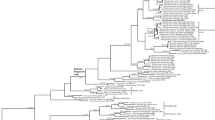Abstract
A corticioid fungal species found in mountainous Taiwan, and Yunnan Province of China, is described as a new genus and new species: Purpureocorticium microsporum (Agaricomycetes, Basidiomycota). Morphological study and phylogenetic analyses based on sequence data respectively derived from the large subunit nuclear ribosomal RNA gene (LSU nrDNA) alone and the combined dataset of LSU nrDNA and translation elongation factor 1-α gene (tef1-α) indicated that Purpureocorticium does not belong to any clade of the Agaricomycetes. Purpureocorticium and P. microsporum are characterized by having a resupinate basidiocarp with smooth hymenial surface which turns purple in KOH, and becomes purplish after storage, microscopically having compact texture of subiculum, nodose-septate thin-walled generative hyphae, absence of cystidia, basidia subclavate with a median constriction, or utriform, bearing ovate-ellipsoid small-sized basidiospores, which are smooth and thin-walled, inamyloid, and nondextrinoid. The new combination Rhizochaete rubescens is proposed, based on morphological and phylogenetic evidences.



Similar content being viewed by others
References
Binder M, Hibbett DS, Larsson KH, Larsson E, Langer E, Langer G (2005) The phylogenetic distribution of resupinate forms across the major clades of mushroom-forming fungi (Homobasidiomycetes). Syst Biodivers 3:113–157. https://doi.org/10.1017/S1477200005001623
Binder M, Larsson KH, Matheny PB, Hibbett DS (2010) Amylocorticiales ord. nov. and Jaapiales ord. nov.: early diverging clades of Agaricomycetidae dominated by corticioid forms. Mycologia 102:865–880. https://doi.org/10.3852/09-288
Binder M, Justo A, Riley R, Salamov A, Lopez-Giraldez F, Sjökvist E, Copeland A, Foster B, Sun H, Larsson E, Larsson KH, Townsend J, Grigoriev IV, Hibbett DS (2013) Phylogenetic and phylogenomic overview of the Polyporales. Mycologia 105:1350–1373. https://doi.org/10.3852/13-003
Boidin J, Lanquetin P (1983) Basidiomycètes Aphyllophoralés épithéloïdes étalés. Mycotaxon 16:461–499
Greslebin A, Nakasone KK, Rajchenberg M (2004) Rhizochaete, a new genus of phanerochaetoid fungi. Mycologia 96:260–271
Hall TA (1999) BioEdit: a user-friendly biological sequence alignment editor and analysis program for Windows 95/98/NT. Nucl Acids Symp Ser 41:95–98
Hall BG (2004) Phylogenetic trees made easy: a how-to manual, 2nd edn. Sinauer Associates, Sunderland
Hibbett DS (2006) A phylogenetic overview of the Agaricomycotina. Mycologia 98:917–925. https://doi.org/10.3852/mycologia.98.6.917
Hillis DM, Bull JJ (1993) An empirical test of bootstrapping as a method for assessing confidence in phylogenetic analysis. Syst Biol 42:182–192
Larsson KH (2007) Re-thinking the classification of corticioid fungi. Mycol Res 111:1040–1063
Li HJ, Cui BK (2013) Taxonomy and phylogeny of the genus Megasporoporia and its related genera. Mycologia 105:368–383. https://doi.org/10.3852/12-114
Nakasone KK (1990) Cultural studies and identification of wood-inhabiting Corticiaceae and selected Hymenomycetes from North America. Mycol Mem 15:1–412
Nobles MK (1965) Identification of cultures of wood-inhabiting Hymenomycetes. Can J Bot 43:1097–1139
Nylander JAA (2004) MrModeltest v2. Program distributed by the author. Evolutionary Biology Centre, Uppsala University
Ronquist F, Huelsenbeck JP (2003) MrBayes 3: Bayesian phylogenetic inference under mixed models. Bioinformatics 19:1572–1574. https://doi.org/10.1093/bioinformatics/btg180
Swofford DL (2002) PAUP*. Phylogenetic analysis using parsimony (*and other methods) version 4. Sinauer Associates, Sunderland
Wu SH (1996) Studies on Gloeocystidiellum sensu lato (Basidiomycotina) in Taiwan. Mycotaxon 58:1–68
Wu SH, Wang DM, Tschen E (2007) Brunneocorticium pyriforme, a new corticioid fungal genus and species belonging to the euagarics clade. Mycologia 99:302–309
Wu SH, Nilsson HR, Chen CT, Yu SY, Hallenberg N (2010) The white-rotting genus Phanerochaete is polyphyletic and distributed throughout the phleboid clade of the Polyporales (Basidiomycota). Fung Divers 42:107–118. https://doi.org/10.1007/s13225-010-0031-7
Acknowledgements
This study was supported by the Ministry of Science and Technology of the ROC (grant no. 104-2621-B-178-001-MY3).
Author information
Authors and Affiliations
Corresponding author
Additional information
Section Editor: Yu-Cheng Dai
Rights and permissions
About this article
Cite this article
Wu, SH., Wang, DM. & Chen, YP. Purpureocorticium microsporum (Basidiomycota) gen. et sp. nov. from East Asia. Mycol Progress 17, 357–364 (2018). https://doi.org/10.1007/s11557-017-1362-5
Received:
Revised:
Accepted:
Published:
Issue Date:
DOI: https://doi.org/10.1007/s11557-017-1362-5




